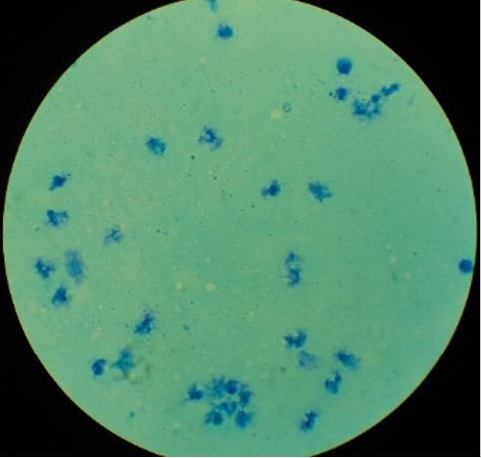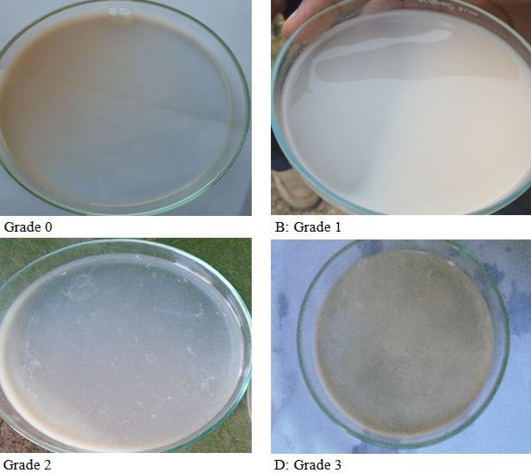Advances in Animal and Veterinary Sciences
Short Communication
Prevalence of Sub-Clinical Mastitis in Cattle and Effect on Milk Quality
Deepak Shankaregowdanakoppalu Jagadeesh1, Ravi Kumar Puttamallappa1*, Hemanth Gowda Keregallokoppalu2, Manjunath Lakshminarasimhiah3
1Department of Veterinary Public Health and Epidemiology, Veterinary College Hassan, KVAFSU; 2Department of Veterinary Physiology and Biochemistry, Veterinary College Hassan, KVAFSU; 3Department of Animal Husbandry and Extension, Veterinary College Hassan, KVAFSU, India.
Abstract | Present study was carried with an objective of finding prevalence of subclinical mastitis (SCM) and effect on milk quality in cross-bred (CB) and desi-dairy cattle (Zebu, Nondescript-ND) of Hassan district, Karnataka, India. Diagnosis was based on cow side tests - California mastitis test, and mastrip which substantiated by Direct Microscopic Somatic Cell Count (DMSCC). Upon evaluation of 150 CB and 40 ND cattle,65 (43%) of CB cattle and 5 (12%) of ND cattle were found positive for SCM on California mastitis test and mastrip test. Overall, 70 of 190 animals (37%) were positive for SCM. The DMSCC enumeration found 0.3-0.5 million SCC per mL for normal and 0.6-1.5 million SCC per mL for SCM positive milk. The milk pH, fat and Solids Not Fat (SNF) exhibited slight variance between normal and SCM positive animals. The prevalence was more common in hygiene and welfare compromised animals.
Keywords | California mastitis test, Somatic cell count, Mastrip, Milk pH, Fat and SNF
Editor | Kuldeep Dhama, Indian Veterinary Research Institute, Uttar Pradesh, India.
Received | May 03, 2016; Accepted | May 26, 2016; Published | May 28, 2016
*Correspondence | Ravi Kumar Puttamallappa, Dept. of Veterinary Public Health and Epidemiology, Veterinary College Hassan, KVAFSU – 573202, Karnataka, India; Email: [email protected]
Citation | Jagadeesh DS, Puttamallappa RK, Keregallokoppalu HG, Lakshminarasimhiah M (2016). Prevalence of sub-clinical mastitis in cattle and effect on milk quality. Adv. Anim. Vet. Sci. 4(5): 237-240.
DOI | http://dx.doi.org/10.14737/journal.aavs/2016/4.5.237.240
ISSN (Online) | 2307-8316; ISSN (Print) | 2309-3331
Copyright © 2016 Jagadeesh et al. This is an open access article distributed under the Creative Commons Attribution License, which permits unrestricted use, distribution, and reproduction in any medium, provided the original work is properly cited.
India stands first in milk production in the world with a production of 146.3 million tons with 322 grams per day per-capita availability of milk during 2014-15 (NDDB, 2016). Indian milk production is mainly by the un-organized vast rural population, which provide alternative and consistent source of income for their livelihood round the year. Mastitis is a problem in dairy farming sector, which affects the farmers economically by decrease in milk yield, withdrawal period losses and exorbitant cost of treatment (Miller et al., 1993). Sub-clinical mastitis is another major economic burden on dairy farming sector, which affects by decreasing the milk yield, milk consistency (density), keeping quality and predisposition to clinical mastitis. Sub-clinical mastitis is the result of compromised farm hygiene, housing system, cow cleanliness, teat-udder hygienic management (Nigel and Douglas, 2007), which increases the incidence of clinical mastitis. The milk composition in sub clinical mastitis condition variation is pronounced (Pleguezuelos et al., 2015). Increased Somatic cell count is an indicator for the development of clinical mastitis in near future (van den Borne et al., 2011).The compromised milk quality and hygiene could affect the population through spread of milk borne zoonotic diseases such as Tuberculosis, Q-Fever, Brucellosis and more (Sharif et al., 2009).
California Mastitis Test (CMT) is a common test for detection of mastitis in dairy cattle, which is also helpful in identifying the sub-clinical mastitis. CMT is based upon reaction of a reagent with the amount of cellular nuclear protein present in the milk sample (Badiuzzaman et al., 2015). Mastrip a commercially available test strip for differentiating clinical, sub-clinical mastitis with normal animals. The estimation of milk pH is aberrantly an indicator for milk quality. The change in electrolyte composition of milk decides the pH, which depends on udder health (Bortolami et al., 2015). The enumeration of Somatic Cell Count is a standard test for diagnosing SCM and also predicts the health of mammary gland and bacteriological status. The Somatic cells include leucocytes (75%) i.e. neutrophils, macrophages, lymphocytes, erythrocytes and epithelial cells (25%). Leucocytes increase in response to bacterial infection, tissue injury and stress (Sharma et al., 2011). SNF includes lactose, protein, minerals and fat content exhibits the quality of milk from normal and SCM milk. The cross bred cattle rearing are extensively for milk production and desi (non-descript-ND, zebu) cattle aids farmer in draught and milk production. The present study was taken up to evaluate the prevalence rate of sub-clinical mastitis in cattle and its effect on milk quality in Hassan district, Karnataka, India.
Selection of animals: Apparently healthy cattle around 2-6 years old, 1-4th lactation and mid milking phase animals were selected for the study. Collection of milk: The udder and teats were washed properly with potable water and rinsed with warm water. Teats were disinfected with 70% alcohol dipped swabs. First few stripping were discarded, mid flow milk was collected in sterile milk bottle and carried to lab under refrigeration temp. For California mastitis test: the milk from 4 teats were drawn into the four chambers on CMT paddle separately. California Mastitis Test (CMT): 2mL of mastitis test reagent (NICETM) mixed with 2mL of milk sample collected in each chamber of paddle and mixed thoroughly by clockwise, anticlockwise, forward and backward movements and results were read within 30sec. Mastrip test: Single test strip dipped on to milk and compared with standards given and corresponding decisions were made. Fat and SNF estimation: Digital milk testing device (Model: KSHEERA, 270A from SUKRATU Technologies). pH: Commercial hand held digital pH meter dipped in milk and values were recorded Somatic Cell Count: 10 µL of milk was spread over 1cm2area on clean glass slide and air dried. Neuman’s stain was applied for 1 minute and washed. A minimum of 10 oil immersion field were enumerated and the average count is noted (Prescott & breed technique of DMSCC).
Formula;
SCC per mL of milk = Avg. count per oif × 100 × Microscopic factor
Out of 150 CB cows tested for SCM, 65 were positive indicating 43 per cent prevalence rate and of 40 ND cattle tested, 5 were positive with 12 per cent prevalence rate for sub clinical mastitis based on CMT. Total of 70 out of 190 animals were positive with prevalence rate of 37 per cent for Sub-clinical mastitis in cattleof Hassan district, Karnataka, India. Mastrip test: strip dip test found similar correlation with CMT test found helpful in identifying border line cases of grade 0 and 1.
The test result of California mastitis test (CMT) was graded as 0, 1, 2 and 3 based on severity of reaction.The results of CMT are depicted in Table 1 and Figure 1.
Table 1: Grading of milk based on California mastitis test (CMT) and DMSCC
|
CMT Grade |
No of Cattle’s |
DMSCC Count |
Fat |
SNF |
pH |
|
0 |
120 (63%) |
3-5 Lakh/mL |
3.56 |
8.73 |
6.7 |
|
1 |
43 (23%) |
4-8 Lakh/mL |
3.49 |
8.65 |
6.9 |
|
2 |
20 (11%) |
6-12 Lakh/mL |
3.44 |
8.61 |
7.0 |
|
3 |
7 (3%) |
10-18 Lakh/mL |
3.37 |
8.52 |
7.1 |
For Fat, SNF and pH average calculated by standard mean
The pH of milk was found to be 6.7±0.1 in normal and 7.0±0.1 in SCM positive cases. The Direct Microscopic Somatic Cell Count (DMSCC) for negative animals on CMT was 0.3-0.5 million per mL and 0.6-1.5 million SCC per mL for SCM positive milk (Figure 2). The fat per cent was 3.5±0.1 in normal milk and 3.4±0.1 in SCM positive cases. The Solids Not Fat (SNF) content was 8.8±0.1 in normal milk and 8.6±0.1in SCM positive cases (Table 1).

Figure 2: Microscopic image of Somatic cell count showing epithelial cells and neutrophils and monocytes
India is self-reliant with milk production in terms of quantity but quality is inferior as per international standards.The need of the hour is to improve the quality of milk and in terms of Somatic cell count and bacteriological parameters. The Sub-clinical mastitis affected milk doesn’t pose any apparent physical changes but microscopically, bacteriological and chemical analysis shows significant variation with normal milk (Pleguezuelos et al., 2015). The increased DMSCC and reduced milk quality parameters are evident in the result of present investigation. The degradation of proteins and fats in milk will often produce off color and odor making the acceptance rate low. The increased SCC denotes increased leucocytes and epithelial cell of bovine origin. Its consumption in human is objectionable on safety of human. The enzymatic action of SCC can also add synergistically for milk spoilage (Sharma et al., 2011).
Milk acts as a vehicle for transmission of many pathogenic organism/disease to man known as milk borne zoonotic diseases. The interrupted cold chain during transport increases the number of pathogenic and spoilage causing organisms in milk and initiates the spoilage, lowering the keeping quality of milk. Bacterial invasion occurs mostly during the dry period, particularly during late gestation, and leads to glandular damage in parenchymatous tissue. The glandular tissue damage leads to increased SCC and reduced milk production (Hillerton et al., 1995). The prevalence of SCM is nearly four times more in CB cattle in comparison to ND cattle.
The increased bacterial concentration is more common in un-hygienically milking practices such as compromised udder and hind quarters cleaning, cow nutrition, pre- and post-milking teat disinfection, and clean milk parlor (Santman-Berends et al., 2016; Nigel and Douglas, 2007). The compromised floor and shed sanitation increases the chances of bacterial invasion to teat cannel (Gordon et al., 2013). The climatic factors also contribute to prevalence of SCM in cattle by increasing SCC and crossbred cattle prevalence is more since its high milk yield and low inherent factors of immunity. Similarly inherent genetic capacity and adaptation to local environment by desi cattle is more. The CB cattle are more susceptible to environment and production stress is considerably high (Saravanan et al., 2015).
The diagnosis of sub-clinical mastitis is simple with California mastitis test (CMT), mastrip test and milk pH estimation which are cow side tests and confirmation by enumeration of DMSCC using simple compound microscope. The increased SCC proportionately decreases the milk quality suggesting increased damage to udder health. The effective management of SCM in bovine reduces the zoonotic disease transmission, increases milk yield, improvement in keeping quality of milk and physico-chemical characteristics of milk. The clean milk production promotion among the farmers helps decrease the prevalence of SCM in dairy animals and improve the animal health and welfare.
Acknowledgement
Authors thank the Dean of Veterinary College, Hassan, KVAFSU for the support, suggestion and providing necessary facilities to carry out the research.
Conflict of interest
The authors declare no conflict of interest.
Authors’ Contribution
Jagadeesh DS contributed for plan of research, manuscript preparation, sampling and experimentation. Puttamallappa RK planned the research, prepared, corrected and revised the manuscript. Keregallokoppalu HG and Lakshminarasimhiah L contributed for sample collection and experimentation.
Reference







